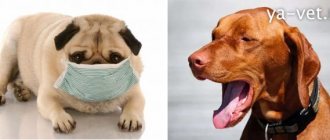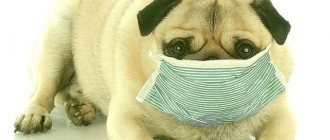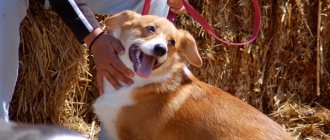In this article we will tell you why dogs grunt. We will describe the main reasons for this phenomenon, such as natural location, entry of a foreign body into the nasal passage, neoplasms, parasites, tracheal collapse, paroxysmal breathing. Let us explain what to do when a dog grunts.
All recommendations described in this article are for informational purposes only. We recommend contacting your veterinarian. Prevention of diseases and successful treatment of pets depends on timely contact with a veterinarian.
Reasons why a dog grunts, chokes and wheezes
There are many reasons why a dog can make sounds similar to the grunting of piglets and snore. The main ones will be discussed below.
Natural predisposition
Dogs with a shortened (flattened) muzzle are called brachycephalic. The brachycephalic group includes the following breeds: pugs, Pekingese, Shar-Pei, Shih Tzu, Japanese Chins, Chihuahuas, Pomeranians, bulldogs, griffins, mastiffs, Lhasa Apso, boxers, Dogues de Bordeaux.
These representatives have a skull shape that differs from the norm. In this case, the head is flattened in the direction from front to back and expanded in cross section. At the same time, the area of the nasal cavity decreases, which affects the movement of air through the nasal passages and the appearance of uncharacteristic sounds. These anomalies are a breed feature and do not require treatment.
The brachycephalic anatomical structure of the nasopharynx leads to a decrease in cooling function. In conditions of elevated ambient temperature, hot air passing through the nasal passages does not reduce the temperature and enters the lungs. In this case, heat strokes often develop. You should definitely take this into account when traveling with a dog and visiting the street in the heat.
Experts consider this phenomenon to be natural and not harmful to the animal. It is also worth noting that the problem begins to develop in the old age of the dog. When muscle and tissue tone is lost, the palate becomes flabby and sags. In this case, the breathing process is disrupted. This problem can be solved surgically in a hospital setting at a veterinary clinic.
Foreign bodies
Dogs are curious explorers. Indoors and outdoors, they always sniff the territory and all objects located on it. Light small particles of earth, plants, debris, insects, when inhaled, can get into the nasal passages and get stuck in them, and the pet can choke.
This can be understood by the following signs:
- the dog suddenly began to sneeze, cough, and grunt;
- scratches his muzzle with his paw, as if trying to remove the muzzle;
- Vomiting may occur.
In order to help your pet, you need to shine a flashlight into the dog’s nose and throat and try to detect the foreign object yourself. If it is visible, you need to secure the dog's head (if the dog breaks out, this should be done by another adult) and slowly and carefully pull out the foreign body with tweezers.
- If you are unable to get the item yourself, you need to take your pet to a veterinary clinic where they will get help. This measure is necessary because The source of the trouble most likely will not come out of the dog’s respiratory tract on its own.
- If the owner does not know how to do this, it is better to seek professional help.
Neoplasms
Oncological diseases, unfortunately, are not uncommon in the animal world, as well as in the human world. A small growing tumor can block the nasal passage like a foreign object and prevent the dog from breathing normally.
You can suspect cancer in a pet based on the following signs:
- wheezing, grunting and snoring are observed for a long time, not associated with the entry of a foreign object into the nasal passages (this is especially true for dogs that are not brachycephalic breeds);
- the dog’s well-being deteriorates, lethargy, apathy, loss of appetite appear, weight decreases and the desire to move;
- A runny nose appears with particles of blood in the secreted mucus.
It is definitely not possible to solve this problem on your own at home using traditional medicine methods. To save a pet’s life, it is necessary to conduct a complete diagnosis, including laboratory and hardware methods, and prescribe competent, effective treatment. Dogs can also develop cancerous tumors in the body.
Parasites
Worm parasitism in dogs occurs not only in the digestive system. There are groups of worms that live in other organs, such as the lungs. Living in the lungs, feeding and reproducing there, worms damage tissue and affect the functioning of the respiratory system.
Poisons and toxins lead to inflammatory processes in the lungs. Symptoms of which are cough, runny nose, copious mucus secretion, gurgling, wheezing, whistling and grunting sounds. These processes lead to pathologies incompatible with life and require urgent professional treatment. If your dog shows signs of helminthic infestation, you should not delay visiting the veterinarian.
Tracheal collapse
If the dog suddenly begins to grunt, breathe heavily, wheeze, wheeze or quack like a duck, and no foreign objects are found in the respiratory tract, the veterinarian may suspect tracheal collapse. This condition is characterized by a narrowing of the trachea, which prevents the passage of air. The dog begins to choke.
Delaying medical help is not recommended. The main symptom of hypoxia in a dog is blue discoloration of the mucous membranes. If you do not provide your pet with veterinary care on time, there is a high probability that he will die.
Paroxysmal breathing
The second name for this phenomenon is reverse sneezing. It manifests itself as a strong sharp intake of air. In this case, the sounds can be different: gurgling, wheezing, sniffling, grunting, cooing, etc. In addition to unusual sounds, other signs are added: the dog’s eyes turn red, drooling profusely, the pose becomes unusual (paws are widely spaced, the back is unnaturally arched). This disease, unfortunately, has no cure and in a third of cases ends in death.
The disease should not be left to chance. It is necessary to consult a doctor for advice and choose a strategy for further behavior. Beginners should consult a veterinarian who can tell you when grunting is alarming.
What to do if your dog is breathing heavily
So, there are many reasons for breathing problems in dogs.
What to do if your dog is breathing heavily? First you need to analyze what the general condition of the animal is. To do this, you need not only to pay attention to the sound of breathing and count the frequency of inhalations and exhalations, but also measure the pulse (normally, this indicator ranges from 70 to 180 beats per minute, for small ones the figure is close to 180 beats, for large ones - to 70). It is important to know what your dog's temperature is. Normally, in a healthy animal, the temperature is 37.5-39 degrees. It would also be useful to measure blood pressure, which in an adult dog should be in the range from 110/60 to 145/95 mmHg.
You definitely need to pay attention to alarming symptoms in the form of stomach and intestinal disorders, changes in the normal shade of the mucous membranes, problems with coordination, loss of appetite, and so on. If your dog is clearly not feeling well, then it’s time to go to the vet.
, since diagnosis at home “by eye” is impossible. Almost always, heavy breathing is a sign of a serious illness, so it is better not to waste precious time.
How often should you visit the veterinarian?
The frequency of visits to the veterinarian should be determined individually, based on the physical condition and age of the dog. There are recommendations for each age, which will be discussed further.
- Dog less than 1 year old: a monthly visit is recommended. It is up to one year that young pets need to have all the necessary vaccinations. The doctor also monitors the development and growth of the dog, whether there are any problems due to a lack of minerals, vitamins, and whether the development corresponds to age. A qualified doctor will definitely draw up a schedule of visits after a thorough examination of your pet. During this period, it is advisable to find a veterinarian who would monitor the dog throughout his life. A kind of family doctor, only for your beloved dog.
- Ages 1-7 years: Recommended annual examination. When the dog is one year old, you need to continue vaccinations according to the previously prescribed veterinary calendar. Don't forget about the annual examination, during which your pet will be thoroughly checked: ears, eyes, nose, heart, lungs, mouth. Only a detailed examination can guarantee the identification of possible symptoms of disease in certain organs. Based on the results of the visit to the veterinarian, recommendations regarding dental care, nutrition, physical activity, etc. will be offered. If there is a suspicion of illness, then additional examinations and tests will be prescribed.
- Ages 8 years and older: Visit your veterinarian every 6 months. Old dogs, like people, are at risk and are more susceptible to various diseases. For this reason, you should visit the veterinarian every six months. In addition to standard examinations, the doctor may prescribe urine, blood, stool tests, x-rays, ultrasound, and blood pressure measurements.
Cases when a trip to the veterinarian should not be postponed
When the dog feels well and no deviations in behavior are observed, it is necessary to visit the veterinarian according to a previously drawn up schedule. However, there are some emergency situations that require emergency assistance from a qualified specialist:
- severe breathing problems are observed;
- the dog was hit by a car;
- the pet does not wake up and is unconscious;
- the dog fell unsuccessfully from a height;
- incessant diarrhea and vomiting throughout the day, pale gums, diarrhea with blood;
- suspected paw fracture or other injury;
- the dog ate something poisonous;
- seizures with convulsions;
- the pet has fallen and does not get up;
- felt a tumor;
- the animal suddenly lost orientation in space;
- the dog whines, hides and trembles;
- other unnatural behavior of the pet.
The dog grunts: what to do, reasons
Diagnosis of respiratory organs
There are many techniques that can help establish a diagnosis. These are instrumental, laboratory, hardware, functional methods.
Diagnosis of the respiratory system includes:
- Ultrasound of the respiratory system.
- Bronchography.
- Fluorography.
- Pleurography.
- Angiography.
- Bronchoscopy.
- Laryngoscopy.
- Thoracoscopy.
- X-ray, fluoroscopy.
- Auscultation, percussion, palpation.
- Serological tests.
- Histological studies.
- CT, MRI.
- Spirometry.
When establishing a diagnosis, the history data, conditions of detention, age, and breed characteristics of the dog are taken into account. In most cases, differential diagnosis is carried out to confirm and establish an accurate diagnosis.
Clinical and home treatment
Treatment methods are selected on an individual basis. The veterinarian, having established the root cause and diagnosis, prescribes effective appropriate treatment for the dog.
Animals are prescribed antiviral, anti-inflammatory, sedative drugs, anthelmintic drugs, immunostimulants, complex antibiotics, sulfonamides, vitamins, and homeopathic remedies.
Antihistamines, corticosteroids (treatment of asthma), antitussives, cardiac glycosides, and pacemakers are used in therapy.
To eliminate attacks of suffocation and allergic reactions that provoke swelling of the larynx, the pet is prescribed Ephedrine, Suprastin, Diphenhydramine, Papaverine, No-shpu, Solutan in injections and tablets. In some cases, artificial ventilation of the dog's lungs is indicated.
If breathing is difficult due to a cold, vasodilators, antibacterial medications, restoratives, and immunomodulators will help normalize the condition.
- Surgical treatment is prescribed to eliminate congenital defects, tracheal collapse, polyps in the nasopharynx, and neoplasms.
- If there are foreign bodies in the respiratory tract, they are removed with special tools and devices.
- In severe cases, the pet is prescribed lifelong maintenance therapy.
Cough prevention
To cure a dog’s cough, whether it is an independent syndrome or a sign indicating some pathology, will require a lot of time, effort and material costs. Some diseases can be forgotten after 2-4 weeks of therapy, others require longer treatment or cannot be treated at all. That is why you should pay maximum attention to preventive measures and follow general recommendations regarding protecting the health of the animal.
Self-examination
In order to promptly notice any deviations in the pet’s health, it is necessary to regularly examine its mucous membranes, coat and skin, monitor the dog’s general activity, its motor skills and musculoskeletal system.
If negative changes associated with at least one parameter are detected, you should immediately contact your veterinarian.
Visit to the veterinarian
Another measure to prevent the development of serious pathologies, as well as a way to avoid their detection at a late stage of development, is regular visits to the veterinarian.
You need to conduct routine examinations with a specialist at least once every six months, ideally quarterly.
Vaccinations
Timely vaccination, carried out according to the schedule, helps the animal develop immunity to most canine viruses, parasitic and fungal diseases, as well as diseases of the central nervous system.
You can vaccinate your dog yourself at home, but a note about vaccination must be in the veterinary passport.
Daily hygiene
The main way to prevent coughing in a dog is to provide proper care, comply with the conditions of keeping the pet and perform hygiene procedures.
It is necessary to provide the animal with a personal place to sleep and rest, which should be warm and soft and located away from drafts - keeping the pet in cold or damp conditions provokes the development of diseases.
There are also requirements regarding nutrition: bowls for water and food must be clean, food must be fresh, cut into small pieces that the dog can swallow without choking, and adherence to the feeding regime will prevent severe hunger and rapid swallowing.
It is also necessary to regularly walk your pet in the fresh air, provide it with the necessary level of physical activity, regularly bathe it and carry out deworming and treatment for external parasites.
Wheezing associated with tracheal collapse or bronchitis
In dogs, the trachea consists of C-shaped cartilage, which is covered by a flexible membrane. In some small breed dogs, this membrane can become loose or loose over time, and when the dog inhales, the trachea can collapse in on itself, narrowing the airway and making it difficult for the dog to breathe.
Tracheal collapse is common in Pugs, Maltese, Shih Tzus, Lhasa Apsos and other small short-nosed breeds. Anxiety or exercise can make this type of wheezing worse.
Chronic bronchitis can also cause scarring of the airways, which can make the bronchi less flexible, leading to persistent wheezing and coughing.











